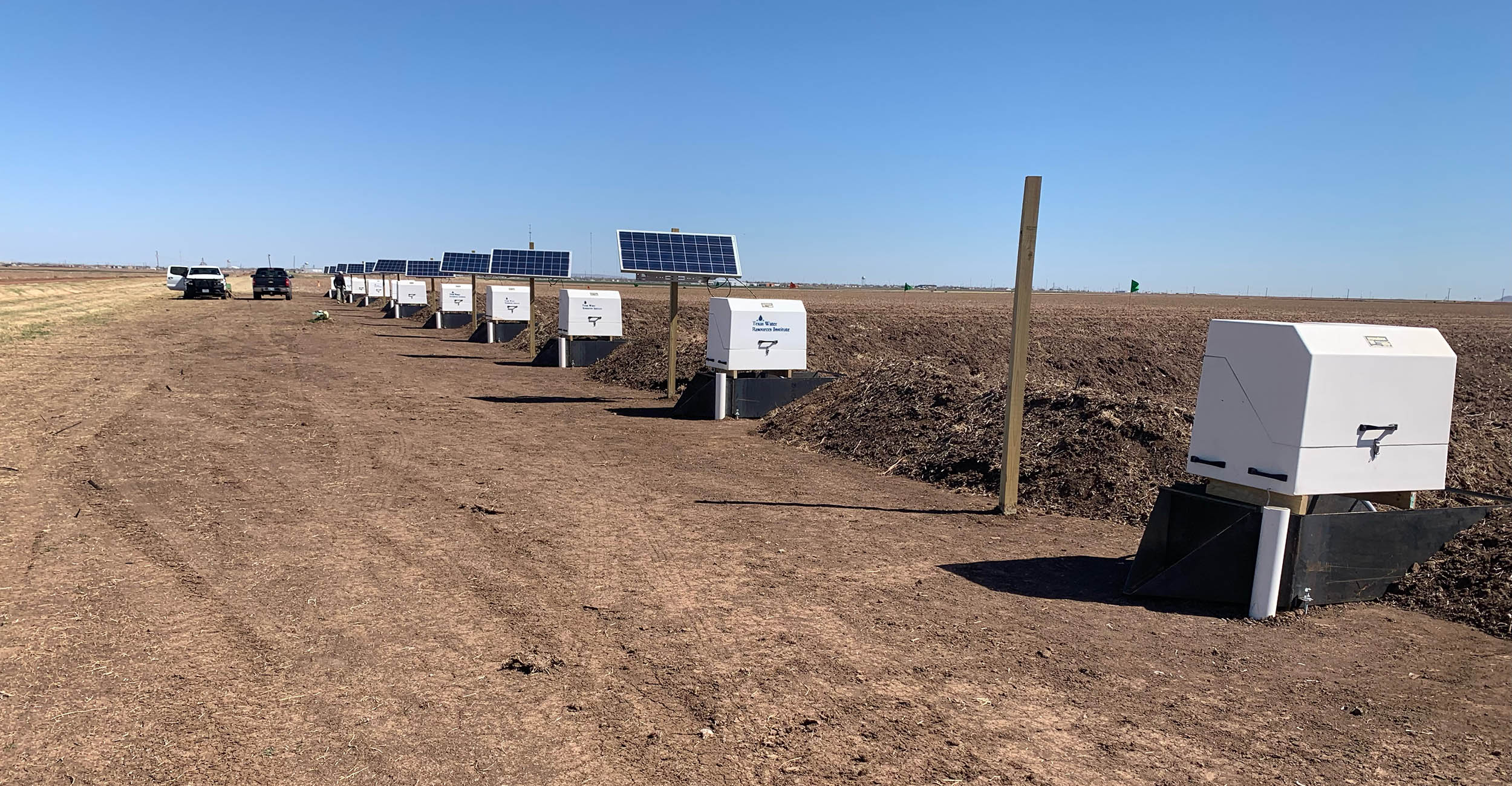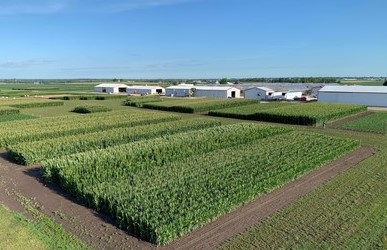Click here to listen to audio
At the 2022 Oklahoma Pork Congress, Senior Farm and Ranch Broadcaster, Ron Hays, had the chance to visit with the Executive Director of the Oklahoma Pork Council, Kylee Deniz. Hays and Deniz talked about t…

Aug 11
Click here to listen to audio
At the 2022 Oklahoma Pork Congress, Senior Farm and Ranch Broadcaster, Ron Hays, had the chance to visit with the Executive Director of the Oklahoma Pork Council, Kylee Deniz. Hays and Deniz talked about t…
Aug 11
The U.S. Grains Council’s (USGC) Southeast Asia and Oceania (SEA&O) office recently led a delegation of U.S. sorghum industry representatives and growers to Vietnam to explore high-value uses of sorghum with regulators and leading buyers and feed mills. The mission produced new opportunities for industry stakeholders in that country to explore the use of sorghum as an alternative feed ingredient for high-value rations, particularly in pet food and aquaculture.
The U.S. sorghum team included growers and representatives from the United Sorghum Checkoff Program (USCP), National Sorghum Producers, Texas Department of Agriculture and the Texas Grain Sorghum Producers Association and Board. The trade mission marked the first official visit by the U.S. sorghum industry to Vietnam since U.S. sorghum gained market access in 2020.
The pathway for U.S. sorghum market access to Vietnam was finalized in May 2020 following the completion of a pest risk assessment and nearly three years of close collaboration between USGC, the U.S. sorghum industry, Vietnam’s Ministry of Agriculture and Rural Development (MARD) and the U.S. Department of Agriculture’s Foreign Agricultural Service (USDA’s FAS) and Animal and Plant Health Inspection Service (APHIS).
“Achieving sorghum market access was a big win for the U.S. sorghum industry”, said Tran Trong Nghia, USGC Vietnam country representative. “The Vietnamese government put in earnest effort to ensure U.S. supply can meet the demand of the Vietnamese people.”
In Hanoi, the sorghum team met with a delegation from MARD, where they discussed methods to mitigate inflationary pressure for feed and food and the benefits of sorghum as an alternative ingredient. The Vietnamese delegation was led by Vice Minister of Agriculture Le Quoc Doanh and included officials from the Plant Protection Department (PPD) and International Cooperation Department (ICD), as well as representatives from two of Vietnam’s largest grain buyers.
The trade team also visited Vietnam’s first industrialized duck raising operation, owned by Mavin, one of Vietnam’s leading agribusinesses that is currently producing 6.5 million ducklings per year. The delegation was briefed on the operating activities of the farm and current dynamics in the Vietnamese duck market and offered information on feed formulations utilizing sorghum.
In southern Vietnam, the mission visited Vin Hoan, the country’s largest producer of pangasius, to discuss the company’s procurement practices and explore potential uses of sorghum in Vietnam’s higher-value aquaculture diets. USGC and USCP have been assessing and promoting the use of sorghum in Vietnamese pangasius diets since 2017, when feeding trials were conducted to test the viability of replacing cassava, a local energy source, with sorghum.
The group also visited Gyuomarch’s Bình D??ng province factory, near Ho Chi Minh City. The sorghum delegation was able to view Gyuomarch’s pet food production process and discuss the potential for sorghum in Vietnamese pet formulations.
“The global pet food market reached $97.47 billion in 2021 and is projected to increase to $136.82 billion by 2028,” said Caleb Wurth, USGC SEA&O regional director. “Vietnam will certainly be part of this growth, and we intend to position our products to participate.”
Vietnam is the largest animal feed market in Southeast Asia, producing over 30.1 million metric tons (MMT) in 2021 and forecasted to surpass 35 MMT of production within the next few years. The country alone produces around 75 percent of the world’s pangasius, a key new-use target for U.S. sorghum and corn co-products.
Learn more about the Council’s work in Vietnam
Aug 11
As lawmakers prepare to write the next farm bill, the American Farm Bureau Federation is sharing stories of its importance to agriculture. Micheal Clements shares more on how the safety net included in the farm bill keeps farmers farming.
…
Aug 11
Oklahoma Farm Bureau, the OKFB Foundation for Agriculture and OKFB Insurance are providing matching funds to county Farm Bureaus that make donations to assist fire departments in their area as Oklahoma battles drought.
All 77 counties i…
Aug 11

The Oklahoma Water Resources Center at Oklahoma State University is teaming up with Texas A&M University for a $1.7 million project to study the benefits of regenerative agriculture in Oklahoma and Texas.
“The water center’s involvement was sparked from discussions on how implementing soil health practices would help achieve Oklahoma’s Water for 2060 goal of consuming no more fresh water in 2060 than was consumed in 2010,” said Kevin Wagner, OWRC director. “There is evidence that practices to improve soil health will also help reach this goal, but there is a need for more research in the Southern Plains.”
Project partners are conducting field research evaluating how the use of cover crops, no till farming and grazing of cover crops effect soil health, soil carbon, nutrient cycling, greenhouse gases emissions, and water quality and quantity. The field research findings will then be used to develop river basin scale models to evaluate the effects of regenerative agricultural practices at a regional scale. Output from these models will be integrated with economic models to show the potential economic impacts on individual producers and surrounding communities.
Although cover crops have been heavily researched in midwestern states, less research has been done in the drier environment of the Southern Plains, according to Wagner, who said part of the project will be studying using wheat as a cover crop for cotton in the Oklahoma panhandle and southwestern regions. Researchers want to understand how cover crops perform in a semi-arid environment with less rainfall and determine the barriers to adoption.
“The focus of this research is cotton as an essential cash crop for southwestern Oklahoma,” Wagner said. “Although cotton provides certain advantages over corn, such as higher tolerance for salinity and lower need for moisture and irrigation, it also has disadvantages, such as leaving very little cover for the soil after harvest.”
The field research kicked off in the spring of 2022 with the installation of 12 water flumes (water collecting devices) at the Southwest Research and Extension Center near Altus. The flumes collect runoff water samples during rain events to study the effects of soil health practices on nutrients, E. coli, and sediment in the runoff water. In preliminary results, researchers found during the first three runoff events that there was three times higher water runoff amounts from the sites without cover crop versus the sites that had an actively growing cover crop in place.
A new Extension Soil Stewardship Program is also being developed to educate producers on soil management and the research findings from the project.
“Producer concerns are always a top priority in our research. It is part of the land-grant mission to extend our research knowledge to the public to help improve the lives of Oklahomans,” Wagner said. “We envision this research being delivered to agricultural producers to provide them with the information they need to assess how integration of regenerative ag practices may benefit their farm and operation.”
OSU Ag Research is Oklahoma’s premier research and technology development agency in agriculture, natural resources and the life sciences.
This work is supported by the Sustainable Agricultural Systems Program?grant no. 2021-68012-35897 from the USDA National Institute of Food and Agriculture. Any opinions, findings, conclusions, or recommendations expressed in this publication are those of the author(s) and do not necessarily reflect the view of the U.S. Department of Agriculture.
Aug 11
Last month (July 2022), the Foreign Agricultural Service of USDA led a trade mission to the Philippines that included representatives from nearly 30 agribusinesses and farm organizations and 10 state departments of agriculture. The primary …
Aug 11

For 75 years, the CHS Foundation has helped develop the next generation of ag leaders for lifelong success. In honor of this milestone, the foundation is awarding $75,000 in grants for K-12 teachers to implement a project at their school that will engage students in experiential agricultural education.
“Throughout the years, it’s the people who have transformed our contributions into life-changing impact for young leaders in agriculture, and teachers have played a major role,” says Nanci Lilja, president of the CHS Foundation. “We are proud of the teachers who put many of these contributions to work, and we’re thrilled that these grants will continue to support their efforts.”
Funds will be awarded for projects that have a strong tie to agriculture and clearly demonstrate how they will engage students in agricultural topics. Teachers are encouraged to dream big, but ideas include implementing a new ag class or pathway or purchasing agriculture equipment for hands-on learning.
Written and video submissions will be accepted until Oct. 1, 2022. First place will be awarded $20,000, second place will receive $15,000 and third place will receive $10,000. An additional 12 finalists will be selected and each receive $2,500. The top three teacher finalists will travel all expenses paid to the CHS Annual Meeting, held in Minneapolis from Dec. 1-2, 2022, to present their idea to a live audience. First, second and third place winners will be decided during live voting by the annual meeting’s attendees.
Additional details:
• The initiative is open to any K-12 educators in a CHS trade territory (Idaho, Illinois, Indiana, Iowa, Kansas, Minnesota, Missouri, Montana, Nebraska, North Dakota, Oklahoma, Ohio, Oregon, South Dakota, Texas, Washington, Wisconsin, and Wyoming).
• Applications must be submitted by a teacher, and applicants must have school administration approval for the project.
“Over the span of 75 years, the CHS Foundation has contributed nearly $84 million to help build a strong agriculture talent pipeline for the future,” says Lilja. “The last 75 years of giving would be nothing without strong educators and students involved in agriculture, and together the next 75 years will be just as bright.”
For more information about the program, visit https://www.chsfoundation.org/teacher-grants. To apply for a grant, visit https://www.surveymonkey.com/r/TN6B7K6.
Aug 11

Bayer puts its industry-leading offerings in crop protection, seeds & traits, and digital farming tools on display today at its Fields of Opportunity Technology Showcase as the company continues to advance innovative products and services tailored toward the individual needs of growers around the globe. Following strong second quarter 2022 financial results, the event demonstrates Bayer’s latest developments in a unique portfolio of solutions and technologies expected to power sustainable growth in the years ahead.
“Today we spotlight technologies designed to reduce agriculture’s impact on the environment, increase food security and help farmers combat the continued pressure of climate change on our global ecosystems,” said Rodrigo Santos, member of the Board of Management of Bayer AG, and President of the Crop Science Division. “Bayer remains committed to providing farmers with the tools they need to be productive and sustainable stewards of their land, especially now as they navigate through current disruptions to agriculture’s supply chains.”
With an annual industry leading R&D investment of more than 2 billion euros in Crop Science alone, Bayer is advancing cutting-edge technologies and breakthrough innovations with a bold and ambitious strategy that will transform the future of farming and position growers for success in a rapidly evolving agriculture industry. The demonstrations and discussions in Jerseyville include:
• Further expansion of ThryvOn™ Technology trials. Building on Bayer’s legacy of contributions to sustainable cotton production through the Deltapine® brand’s genetic advancements and Bollgard® brand’s trait technologies, ThryvOn Technology will be the industry’s first biotechnology trait that will provide built-in protection to the whole plant against key tarnished plant bug and thrips species. 2022 will see farmer trials increase to nearly 60,000 acres, bringing this biotech cotton trait one step closer to helping farmers more effectively manage insect pressure.
• Plans for hundreds of on-farm pilot plots of Short Stature Corn hybrids in North America in 2023. These hybrids form the anchor of Bayer’s Smart Corn System, farmers precise in-season management of their fertilizer and crop protection needs, thanks to the power of the Climate FieldView™ digital platform. These hybrids recently proved their ability to withstand severe weather conditions when extreme windstorms blew through the Midwest.
• Following the company’s recently announced increased investment, Bayer will highlight CoverCress™, a renewable oilseed and animal feed crop with an annual winter growth cycle allowing its use in between corn and soybean rotations. CoverCress™ will help deliver on Bayer’s sustainability commitments and may open additional revenue streams for growers.
In addition to products yet to be launched, the company notes key updates on recently launched next-generation technologies. Growth across programs and products advancing in the pipeline include:
• The launch of the next-generation technology Intacta 2 Xtend® offers a significant performance advantage for Brazilian soybean farmers delivering about 2.9 bushels more per acre compared to similar varieties on the market. Bayer leads the industry in protecting soybean yield against insect and weed pressure with the third-generation technology in Phase 3 and the fourth generation moving to Phase 1.
• The company also reaffirmed performance advantages of critical fungicides such as Fox® Supra for soybeans in Brazil, expected to launch later this year, and Delaro® Complete fungicide in the North America corn market.
• Additionally, Bayer is making progress in bringing the first new herbicide mode of action in the past 30 years for post-emergent control of weeds across all major row crops. Currently in Phase 3, the technology is showing excellent performance.
• The Bayer Carbon program continues to develop across 10 countries. Bayer PRO Carbono, the largest carbon program in Brazil, is seeing impressive enrollment and excellent results. Participating soybean growers register carbon emissions 70% lower than the national average in Brazil and 80% lower than the global average, per ton of soybeans produced.
• Increasing adoption of the number one brand in digital ag, Climate FieldView™, is now on more than 200 million acres in 23 countries around the world as Bayer continues to lead the digital transformation of agriculture. The next frontier of value creation is about more than bringing better individual inputs, but rather in digitally enhancing those solutions to optimize yields, create efficiencies and improve returns.
“Bayer’s advancements in agriculture are incredibly powerful, scientific solutions designed for farmers of all scales in all geographies and are made possible through our continued progress in developing digital tools,” said Bob Reiter, Head of R&D for the company’s Crop Science Division. “We are putting insights by our plant breeders, data scientists, and agronomists on display here today. Through these tailored solutions, empowered by our digital platforms, we provide growers with the key to be as sustainable and successful in every part of their operation as they can.”
About Bayer
Bayer is a global enterprise with core competencies in the life science fields of health care and nutrition. Its products and services are designed to help people and the planet thrive by supporting efforts to master the major challenges presented by a growing and aging global population. Bayer is committed to driving sustainable development and generating a positive impact with its businesses. At the same time, the Group aims to increase its earning power and create value through innovation and growth. The Bayer brand stands for trust, reliability and quality throughout the world. In fiscal 2021, the Group employed around 100,000 people and had sales of 44.1 billion euros. R&D expenses before special items amounted to 5.3 billion euros. For more information, go to www.bayer.com.
Aug 11
U.S. and Canadian ag tractor monthly unit sales in July 2022 fell, while harvester sales grew in the U.S., according to the latest data from the Association of Equipment Manufacturers (AEM).
U.S. total farm tractor sales fell 21 percent …
Aug 11
Last week, members of National Corn Grower Association’s (NCGA) Corn Sustainability Advisory Group (CSAG) came together in Philadelphia. NCGA formed the CSAG in 2019 to proactively drive U.S. corn’s sustainability story and to b…